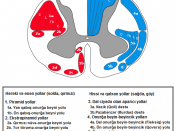Achondroplasia
Achondroplasia is the most common form of short-limbed dwarfism. It is a chondodystrophy in which the development of cartilage and bone is disturbed. The disorder occurs in approximately one out of every 10,000 births (Gale Encyclopedia of Medicine 1999 page 17). It is found in both males and females of all races. Adult male achondroplastic dwarfs average 51.8 inches in height while females average 48.6 inches (Human Growth Foundation 1975). Its depiction in ancient Egyptian art makes it one of the oldest recorded birth defects.
The word achondroplasia derived from Greek and means "without cartilage formation", although people with the disorder do have cartilage. Normal bone growth depends on the production of cartilage, a fibrous connective tissue. Over time, calcium is deposited within the cartilage, causing it to harden and become bone. In achondroplasia, abnormalities of this process prevent the bones, especially those in the limbs, from growing as long as they normally should, at the same time allowing bones to become abnormally thickened.
During the fetal development and in early childhood cartilage normally develops into the bone, except for a few places such as the nose and ears. The rate at which cartilage cells in the growth plates of the femur and humerus bones turn into bone is slow, leading to short bones and reduced height.
Achondroplasia is one of only a few defects to increase in frequency with the increasing age of the father. Most genetic defects are linked to the increasing age of the mother. It is inherited by an autosomal dominant gene that causes abnormal cartilage formation. The gene is located in one of the chromosome pairs one through twenty-two which means males and females are equally affected. The gene is dominant which meaning only one gene is necessary to have the trait. Nine out...


